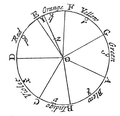Newton's_colour_circle.png (400 × 385 píxeles; tamaño de archivo: 66 kB; tipo MIME: image/png)
Historial del archivo
Haz clic sobre una fecha y hora para ver el archivo tal como apareció en ese momento.
| Fecha y hora | Miniatura | Dimensiones | Usuario | Comentario | |
|---|---|---|---|---|---|
| actual | 03:03 29 oct 2019 |  | 400 × 385 (66 kB) | Sam Van Kooten | Replaced with a higher-quality version taken from the Project Gutenberg eBook of the 1730 4th-edition printing of Opticks. |
| 13:11 23 dic 2018 |  | 398 × 394 (32 kB) | Qpoi9762 | I removed spots. | |
| 16:17 5 mar 2010 |  | 398 × 394 (20 kB) | Maximkaaa | {{Information |Description={{en|1="In a mixture of primary colours, the quantity and quality of each being given, to know the colour of the compound." Throughout ''Opticks'', Newton compared colours in the spectrum to a run of musical no |
Usos del archivo
Las siguientes páginas usan este archivo:
Uso global del archivo
Las wikis siguientes utilizan este archivo:
- Uso en az.wikipedia.org
- Uso en ban.wikipedia.org
- Uso en bn.wikipedia.org
- Uso en en.wikipedia.org
- Uso en eu.wikipedia.org
- Uso en fr.wikipedia.org
- Uso en fr.wikiversity.org
- Uso en gl.wikipedia.org
- Uso en he.wikipedia.org
- Uso en hu.wikipedia.org
- Uso en id.wikipedia.org
- Uso en it.wikipedia.org
- Uso en pl.wikipedia.org
- Uso en ru.wikipedia.org
- Uso en vi.wikipedia.org

